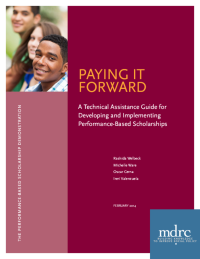Paying It Forward
A Technical Assistance Guide for Developing and Implementing Performance-Based Scholarships

Difficulties in paying for college and in maintaining good academic performance are two major hurdles to college graduation for low-income students. In recent years, state and federal budgets for postsecondary education have been cut significantly, limiting the options policymakers, education leaders, and communities have to improve rates of college attendance and graduation. Even when tuition and fees are covered by state and federal financial aid, lack of resources to help pay for other costs of attendance (such as book and living expenses) can lead students to choose to work more at paid jobs, and as a result, study less or interrupt their studies. Additionally, many low-income students, particularly in community colleges, lack the foundational academic skills they need. Underpreparation for college-level work and limited resources may reinforce each other, contributing to the current stagnation in college graduation rates for low-income students.
Performance-based scholarships, which simultaneously address the financial and academic challenges that many low-income students face, is one strategy that may help boost rates of academic success and graduation for this population. A performance-based scholarship is need-based aid designed to help reduce the financial burden on a low-income student, while at the same time providing incentives for good academic progress. With these scholarships, students generally are given financial aid, often at multiple points during the semester, if they maintain a C average or better and earn a certain number of credits. The incentives that are built into the scholarships are intended to encourage students to focus on their studies, which should lead them to perform better in their classes in the short term. In the medium term, they should progress through their degree requirements more quickly, and, in the long term, this progress may help them graduate or transfer to four-year colleges.
This guide offers helpful information and tools for developing and implementing a performance-based scholarship program. Drawing on the research findings and experiences from two research demonstrations that tested the effectiveness of performance-based scholarships for different types of students in diverse academic settings, this guide provides details on:
- Alternative designs for performance-based scholarship programs used in several community colleges, a four-year college, and two portable scholarship programs, and
- Components needed to design, plan, and implement a performance-based scholarship program.
The intended audience for this guide are staff members of two- or four-year colleges and of government or nonprofit organizations that offer scholarships. The guide offers readers lessons, advice, and clear steps for adding performance components to an existing scholarship program or for developing a new one. Collectively, the information in this guide is intended to help scholarship providers to be more purposeful and efficient when making decisions about whom they choose as recipients, how the awards are offered, and what to expect from recipients. Rather than being prescriptive, the guide aims to help these providers make choices that best fit their circumstances and those of their students — choices that will ultimately result in strong implementation of a strategy designed to make it easier for students to meet their financial needs and succeed academically.






